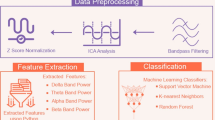Abstract
Electromyographic (EMG) signals are abundantly used in the field of rehabilitation engineering in controlling the prosthetic device and significantly essential to find fast and accurate EMG pattern recognition system, to avoid intrusive delay. The main objective of this paper is to study the influence of Principal component analysis (PCA), a transformation technique, in pattern recognition of six hand movements using four channel surface EMG signals from ten healthy subjects. For this reason, time domain (TD) statistical as well as auto regression (AR) coefficients are extracted from the four channel EMG signals. The extracted statistical features as well as AR coefficients are transformed using PCA to 25, 50 and 75 % of corresponding original feature vector space. The classification accuracy of PCA transformed and non-PCA transformed TD statistical features as well as AR coefficients are studied with simple logistic regression (SLR), decision tree (DT) with J48 algorithm, logistic model tree (LMT), k nearest neighbor (kNN) and neural network (NN) classifiers in the identification of six different movements. The Kruskal–Wallis (KW) statistical test shows that there is a significant reduction (P < 0.05) in classification accuracy with PCA transformed features compared to non-PCA transformed features. SLR with non-PCA transformed time domain (TD) statistical features performs better in accuracy and computational power compared to other features considered in this study. In addition, the motion control of three drives for six movements of the hand is implemented with SLR using TD statistical features in off-line with TMSLF2407 digital signal controller (DSC).






Similar content being viewed by others
References
Ajiboye AB, Ff Weir RF (2005) A heuristic fuzzy logic approach to EMG pattern recognition for multifunctional prosthetic control. IEEE Trans Neural Syst Rehabil Eng 13:280–291
Chu J, Moon I, Mun M (2006) A real-time EMG pattern recognition system based on linear-nonlinear feature projection for a multifunction myoelectric hand. IEEE Trans Biomed Eng 53:2232–2239
Das K, Osechinskiy S, Nenadic Z (2007) A classwise PCA-based recognition of neural data for brain computer interfaces. Proc IEEE EMBS, Lyon, pp 6519–6522
Englehart K, Hudgins B, Parker PA (2003) A robust real-time control scheme for multifunction myoelectric control. IEEE Trans Biomed Eng 50:848–854
Friedman J, Hastie R, Tibshirani (2000) Additive logistic regression: a statistical view of boosting. J Ann Stat 38:337–374
Geethanjali, P and Ray KK (2013) Statistical pattern recognition technique for improved real-time myoelectric signal classification. Biomed Eng—Appl, Basis Commun. 25(2):1–9
Geethanjali P, Ray KK, Vivekananda Shanmuganathan P (2009) Actuation of prosthetic drive using EMG signal. Proceedings of IEEE International Conference TENCON, Singapore, pp 1–6
Gioioso G, Salvietti G, Malvezzi M, Prattichizzo D (2013) Mapping synergies from human to robotic hands with dissimilar kinematics: an approach in the object domain. IEEE Trans Robotics 29:825–837
Hargrove L, Losier L, Lock B, Englehart K, Hudgins B (2007). A real-time pattern recognition based myoelectric control usability study implemented in a virtual environement. Proceedings of 29th Annual International Conference of the IEEE EMBS, pp 4842–4845
Hargrove LJ, Li G, Englehart KB, Hudgins BS (2009) Principal components Analysis preprocessing for improved classification accuracies in pattern-recogniton-based myoelectric control. IEEE Trans Biomed Eng 56:1407–1414
Hudgins B, Parker PA, Scott RN (1993) A new strategy for multifunction myoelectric control. IEEE Trans Biomed Eng 40:82–94
Kruger U, Zhang J, Xie L (2007). Developments and applications of non-linear principal component analysis a review, in Principal Manifolds for Data Visualization and Dimension Reduction, 58:1–44
Landwehr N, Hall M, Frank E (2005) Logistic model trees. J Mach Learn 59:161–205
Bin Ahmad Nadzri AA, Ahmad SA, Marhaban MH, Jaafar H (2014) Characterization of surface electromyography using time domain features for determining hand motion and stages of contraction. Australas Phys Eng Sci Med 37(1):133–137
Naik GR, Arjunan S, Kumar DK (2011) Applications of ICA and fractal dimension in sEMG signal processing for subtle movement analysis: a review. Australas Phys Eng Sci Med 34(2):179–193
Naik GR, Kumar DK, Palanizwami M (2010) Classification of low level surface electromyogram using independent component analysis. IET Signal Proc 5:479–487
Naik GR, Kumar DK (2010) Twin SVM for gesture classification using the surface Electromyogram. IEEE Trans Inform Technol Biomed 14:301–308
Phinyomark A, Phukpattaranont P, Limsakul C (2012) Feature reduction and selection for EMG signal classification. Expert Syst Appl 39:4420–7431
Quinlan JR (1996) Improved use of continuous attributes in C4. 5. J Artif Res 4:77–90
Witten LH, Frank E (2005) Data Mining: Practical Machine Learning Tolls and Techniques. Morgaun Kanfaman Press, San Francisco
Author information
Authors and Affiliations
Corresponding author
Rights and permissions
About this article
Cite this article
Geethanjali, P. Comparative study of PCA in classification of multichannel EMG signals. Australas Phys Eng Sci Med 38, 331–343 (2015). https://doi.org/10.1007/s13246-015-0343-8
Received:
Accepted:
Published:
Issue Date:
DOI: https://doi.org/10.1007/s13246-015-0343-8




